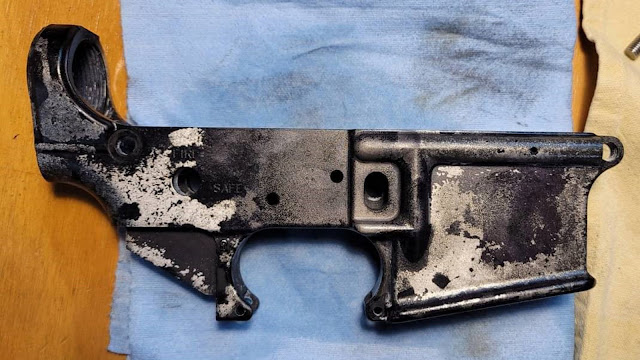Frog Lube is a family of non-petroleum, non-toxic, food-grade, bio-based solvents and lubricants. When used properly, they can be quite effective, though I’ve read mixed reviews. Unfortunately, if excess Frog Lube is left on a firearm, it turns into a gummy mess. My father’s AR was so gummed up that flipping the safety was like pushing a wooden spoon through cold molasses. Something needed to be done to fix this
I tried scrubbing it down with CLP, my preferred cleaner, but that only slightly improved the situation. Ultimately, I stripped it down completely to the last pin and spring, then put the lower into an ultrasonic cleaner with my standard degreaser. Normally I dilute this with water, but because of how stubborn the buildup was, I skipped that step.
This turned out to be a mistake. When I pulled the lower out of the ultrasonic cleaner, not only had the built-up and congealed lubricant been removed, but also much of the finish.
 |
The receiver as it came out of the ultrasonic cleaner |
In my post on metal finishes, I talked about the aluminum finish called anodizing, which is basically a controlled oxidation of aluminum like bluing is for steel. Somehow the degreaser, the microbubbles generated by the ultrasonic cleaner, and the finish on this particular lower did not get along, leaving the lower a patchwork of bare metal and distressed finish. This was a less than optimal outcome, but the lower wasn’t damaged or weakened in any way; it just looked like it had the firearm equivalent of mange.
To clean up the surface in preparation for refinishing I ran the lower through the wet tumbler I mentioned in my post on brass cleaning. Some of the stainless steel pins I was using as cleaning media had a tendency to get stuck in the pivot pin spring channel until I plugged it with a bit of wiring insulation, but the result was a considerable improvement.
 |
After several hours in the wet tumbler |
I decided that since I was going to put a new finish on this lower anyway, I’d optimize it for use on my retro AR PCC. This involved filling the right side Safe and Fire markings with JB Weld and, once hardened, sanding it smooth and flush with the surface of the lower.
To get the proper look for my retro AR, I chose Brownells Aluma-Hyde II Dark Parkerizing Grey, an epoxy based spray finish. Aluma-Hyde is one of a number of spray finishes available on the market, others include Duracoat, Ceracoat, and Norrell’s. They can all be used to refresh old or damaged items to new, or even better than new appearance.
When using this type of finish, proper surface preparation is essential, and always check the instructions that come with the product.
- The item needs to be clean, dry, and grease free. To achieve this, I used some Remington Action Cleaner & Degreaser I’ve had for many years.
- Using baling wire, I hung the lower suspended inside an upended cardboard box as a sort of makeshift painting booth.
- After thoroughly shaking the can, I proceeded with short, light bursts of finish until I had a good base coating. Then I left it to dry.
The results were fabulous and exactly what I was hoping to see: a nice even coat of dark grey. The lower needs to sit for a few more days before it’s completely cured and ready for reassembly.
In the words of Joe Gill from Crossfire Trail: "If you take your time, you get a more harmonious outcome."


